________________
Brahma and Sama
187
addressed to Agni. The poet who had the romantic experience of the night enveloped in blinding darkness, composed the sūkta addressed to Rātri-night. The same thing can be stated of speech-Vak, time etc., that are eulogized in sūktas. There may be different aspects of nature or some divine elements hidden in them or there can be some supreme bidden power behind them all. One thing is. certain that when the Vedic poets composed the hymns, they reso. rted to one or the other symbol of the visible nature. The prayers that take recourse to these different symbols are known as Brahma.
Several meanings of the word "Brahma' evolved in course of time froin this primary meaning. Even the sacrifices in which these sūktas were made use of, came to be known as Brahma. Even the works narrating this and the Purohitas performing sacrifices were koown as Brahma, Brahma or Brahmaņa. In the ancient time itself, these different phases and aspects of nature or the divine elements were classed as just one element. Even in the first Mandala of the Rgveda itself, it is clearly and specifically stated that the gods originating from different elex eots known as Indra, Mitra, Varuņa, Agni etc. that are sung and eulogized as different gods, are, ultimately just one element and this one element is 'Sat.' In this manner, so many symbols of nature ultimately merged themselves into one supreme element known as Sat. The idea continued to develop and expand in several ways. The background of śramana and Brāhmaṇa thinking
The worshippers of the spirit of equality-Sama --- were known. as Somana or Sumaņa. The word is transformed into Sanskrit as Sumana or Sramana. But since the word Sama is originally a Sanskrit word, its form in Sanskrit comes to be Samana. The worshippers and thinkers on Brahmanas were known as Brahmaņas. The first class -Samaņas--remained pre-dominantly introspective and aiming just at Ātmā; the other - brahmanas. --being inspired by universal • Praksti' that had reached the most subtle reality through its symbols, remained aiming at Prakrti. Thus, the original source of inspiration of one and the other was different. Still, the streams of intellect of both were flowing towards some ultimate truth.
Jain Education International
For Private & Personal Use Only
www.jainelibrary.org




